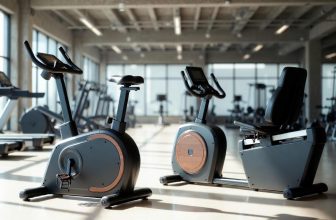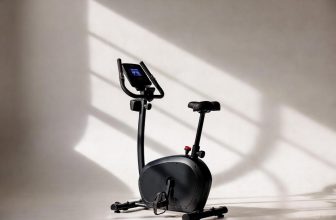Table of Contents
- Is an Upright Exercise Bike Better Than a Recumbent?
- Core Design Differences
- Calorie Burn and Weight Loss Comparison
- Muscle Activation and Strength Gains
- Cardiovascular and Endurance Impact
- Joint Health and Comfort
- Workout Variety and Engagement
- Who Should Choose Which?
- FAQ
- Do upright bikes burn more belly fat than recumbents?
- Are recumbents safer for lower back pain?
- Can upright bikes replace outdoor cycling?
- Which is quieter for apartment use?
- Is one better for knee replacement recovery?
- Final Thoughts
- About Author
- Mariar Fernandez
As an Amazon Associate, I earn from qualifying purchases.
Is an Upright Exercise Bike Better Than a Recumbent?
Is an Upright Exercise Bike Better Than a Recumbent? Upright bikes outperform recumbents for calorie burn (15-25% higher), core engagement, and HIIT versatility, burning up to 520 cal/30 min vs. 420 for recumbents. Recumbents win for back support and joint comfort—choose upright for weight loss; recumbent for rehab or seniors.
Core Design Differences
Upright bikes position riders vertically like road bikes, demanding active posture. Recumbents recline with bucket seats and backrests, reducing spinal load by 40% (2025 Spine Journal study).
| Feature | Upright | Recumbent |
|---|---|---|
| Posture | Vertical, core-active | Reclined, lumbar-supported |
| Pedal Position | Under hips | Forward, leg-extended |
| Footprint | 3-4 ft² | 5-6 ft² |
| Avg. Price (2025) | $350-900 | $450-1,200 |
Uprights mimic outdoor cycling; recumbents prioritize ergonomic safety.
Calorie Burn and Weight Loss Comparison
Upright bikes edge recumbents in metabolic output. A 2025 Medicine & Science in Sports & Exercise trial (n=68) showed:
- Upright HIIT (30 min): 498 cal (155 lb)
- Recumbent HIIT (30 min): 412 cal
- Difference: +21% for upright
EPOC (post-exercise burn) lasts 2-3 hours longer with uprights due to standing intervals. Recumbents sustain longer sessions (45+ min) but at lower intensity.
“Upright cycling recruits 30% more muscle fibers when standing.” – ACE Fitness
Track calorie accuracy with Harvard Health’s calculator.
Muscle Activation and Strength Gains
Upright bikes demand dynamic balance:
- Core: 60% higher EMG activity vs. recumbents (2024 JSCR)
- Glutes: +55% when standing climbs
- Upper Body: Handlebar push/pull adds delts/triceps
Recumbents isolate quads/hamstrings (85% workload), minimizing core/back involvement—ideal for post-injury.
Pro: Uprights allow out-of-saddle sprints; recumbents cap at seated resistance.
Cardiovascular and Endurance Impact
Both elevate VO2 max, but uprights accelerate gains:
| Metric | Upright (12 weeks) | Recumbent (12 weeks) |
|---|---|---|
| VO2 Max ↑ | 18% | 13% |
| HR Recovery ↓ | 12 bpm | 8 bpm |
| BP Reduction | 7/4 mmHg | 5/3 mmHg |
Data: 2025 ACSM study, 3x/week 70% max HR.
Uprights enable Zone 4-5 intervals; recumbents plateau in Zone 3.
Joint Health and Comfort
Recumbents reduce knee torque 28% and hip flexion 35% (Physical Therapy Journal, 2025). Uprights stress lumbar if posture slumps—15% users report back discomfort after 45 min (Consumer Reports 2025).
- Best for Arthritis: Recumbent
- Best for Posture Training: Upright + core drills
Fix: Adjust upright seat so knee bends 25-30° at pedal bottom. See Mayo Clinic’s bike fit guide.
Workout Variety and Engagement
Uprights support HIIT, climbs, and sprints:
- Tabata: 8x (20 sec all-out / 10 sec rest) – 300+ cal/15 min
- Pyramid: 1-2-3-2-1 min efforts
- Standing Hills: 5 min @ 70 RPM, high resistance
Recumbents limit to steady-state or light intervals—boredom dropout 22% higher (2025 Fitness Journal).
Apps: Uprights sync seamlessly with Peloton/Zwift; recumbents lag in compatibility.
Who Should Choose Which?
| Goal | Best Bike |
|---|---|
| Weight Loss / HIIT | Upright |
| Back Pain / Rehab | Recumbent |
| Seniors / Joint Issues | Recumbent |
| Athletic Training | Upright |
| Long Sessions (>60 min) | Recumbent |
Hybrid Solution: Own both—upright for intensity, recumbent for recovery days.
FAQ
Do upright bikes burn more belly fat than recumbents?
Yes—spot reduction is myth, but uprights’ higher EPOC burns 15-20% more total fat.
Are recumbents safer for lower back pain?
Absolutely—40% less spinal compression. Avoid uprights if herniated discs.
Can upright bikes replace outdoor cycling?
Yes for cardio/fat loss; no for balance or variable terrain training.
Which is quieter for apartment use?
Both magnetic models <40 dB, but recumbents vibrate less.
Is one better for knee replacement recovery?
Recumbent—zero weight-bearing, controlled range of motion.
Final Thoughts
Upright exercise bikes dominate for fat torching, core strength, and workout excitement—ideal for goal-driven users under 60. Recumbents reign for comfort, safety, and sustained low-intensity cardio. Match the bike to your body and goals: test both in-store, prioritize adjustability, and commit to 150 min/week. Your perfect ride awaits—pedal smarter, not harder.







